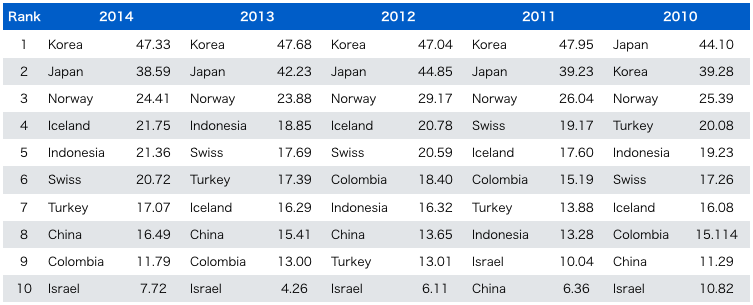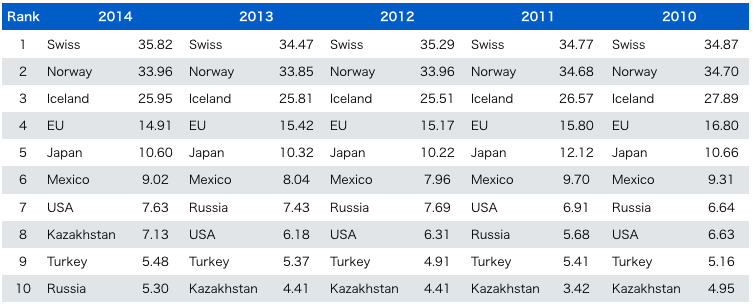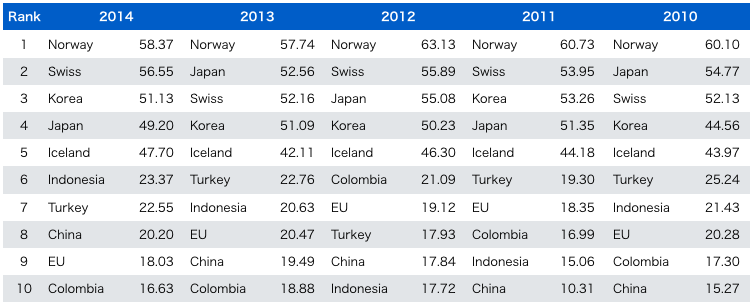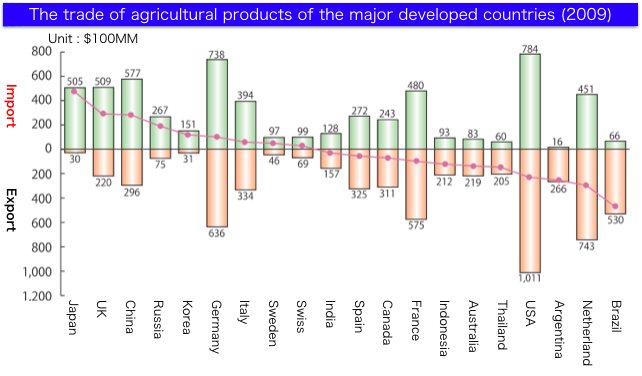Regarding the issues of the agriculture in Japan, which I wrote in my blog the other day, I took a look at the statistical data to cover this issue in depth.
Each country has announced its Producer Support Estimate (PSE). In short, PSE is a numerical data, which shows how much burden each government put on its nationals against the real ability of its agriculture in order to be consistent. Anyway, there are roughly two ways to protect the agriculture.
The first one is eliminating the advantage of import products by putting taxes to adjust the price difference between the low-cost overseas products and the domestic products. It can be said that this is an unfair way to set the price of overseas products high since the domestic products have no competitive power. For example, approximately 700% import tax is imposed on Japanese rice, which we believe “a high-quality and the most delicious rice in the world”. I think we pay more money for better quality products, so there is no problem even if low-priced rice are coming into Japan from overseas. I can’t understand why the Japanese government is trying to protect the Japanese domestic rice with such a high import tax.
The case of Konjac is worse. The import tax is actually over 1700%. I think we should give up the products which cost a lot to grow in Japan. We should use low-priced Konjac from other countries, like Myanmar, to make Konjac with. Is there any problems for that?
Just for your information, the chart below shows the top ten countries with “price protection rate”, which impose so much import taxes on any products to cover its low competitiveness.
For last five years, Japan and Korea were ranked the first and the second honorably (lol). I think both countries have so much pride to use the domestic products, not the products from overseas. Well, if so, I don’t think that we need the government protection. We simply leave each consumer options to choose products…, is this idea something wrong?
The second way to protect the agriculture is so-called “subsidy”. As you know, some amount of taxes we pay are used as subsidy. I am pretty sure that there are some appropriate reasons why the field of agriculture gets the subsidy, but on the other hand, I still feel it is a little bit unfair because there are so many people who works so hard on the field without any subsidy. Well, I guess having this feeling is one of the characters of subsidy, isn’t it? Anyway, we call it as “financial protection rate”, let’s see the top ten countries of this rate as well.
Again, Japan is ranked within the top five of this field. Korea, which was competing with Japan for the first and the second places of the earlier topic, isn’t ranked in this time.
Well, now, let’s take a look at the world top ten of “Producer Support Estimate”, which combines “the price protection rate” and “the financial protection rate”.
Oh, what a bummer. Japan was ranked as fourth place after Korea on Year 2014. But a year before, on Year 2013, we were proudly at the second place (lol). In addition, the difference between all of the top five and the sixth place is more than a double. This data is definitely showing that “how extreme these countries are to pumper the field of its agriculture” and the extremeness is insane. Even though we ignore the details of ranks or numbers, it is obvious that Japan, even among 196 countries, is a country, which strongly protects its own agriculture.
When I see these data and the pampering toward the agriculture in Japan, my biggest question is that for what Japanese government is doing this pampering. Regarding the Japanese agriculture itself, we are implementing very inefficient and unproductive ways compared to the advanced agriculture countries. I think that instead of protecting the agriculture (or the farmer?), we should launch the front-line technologies and knowledges to make the field of agriculture competitive in the world. Or, if we say a developed country should not rely on the primary industry, we should abolish the tariffs and import low-priced and high-quality products… is it right, isn’t it?
Well, as you see from the fact of “the trade of agricultural products of the major developed countries”, Japan has the biggest trade deficits in the field of agriculture.
Even though the field of agriculture in Japan is protecting its own agriculture most amazingly, it is also making the world biggest trade deficit. Furthermore, it is Japanese nationals who support it by purchasing unfairly high-priced products and paying the subsidy through the taxes. Or perhaps, the issue of building the national stadium is a kind of good example, there are so much uncertain money are used for not only the field of agriculture, but any kinds of fields as well and as a result, the trade deficit is getting bigger and bigger, I think. As I see everything from the outside, now Japan is driving Japanese yen straight into just paper scraps.
Can we really stay the way we are?





